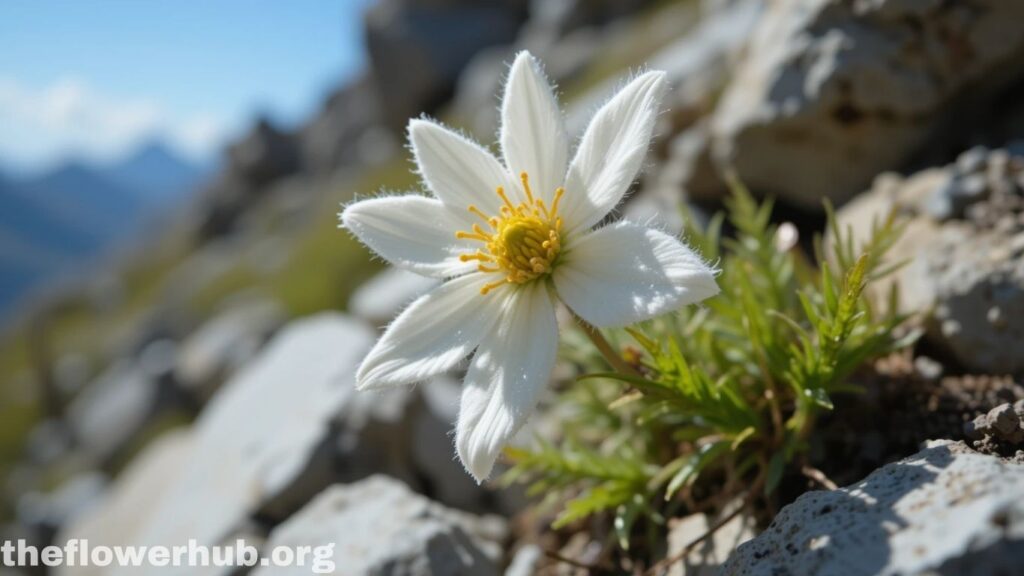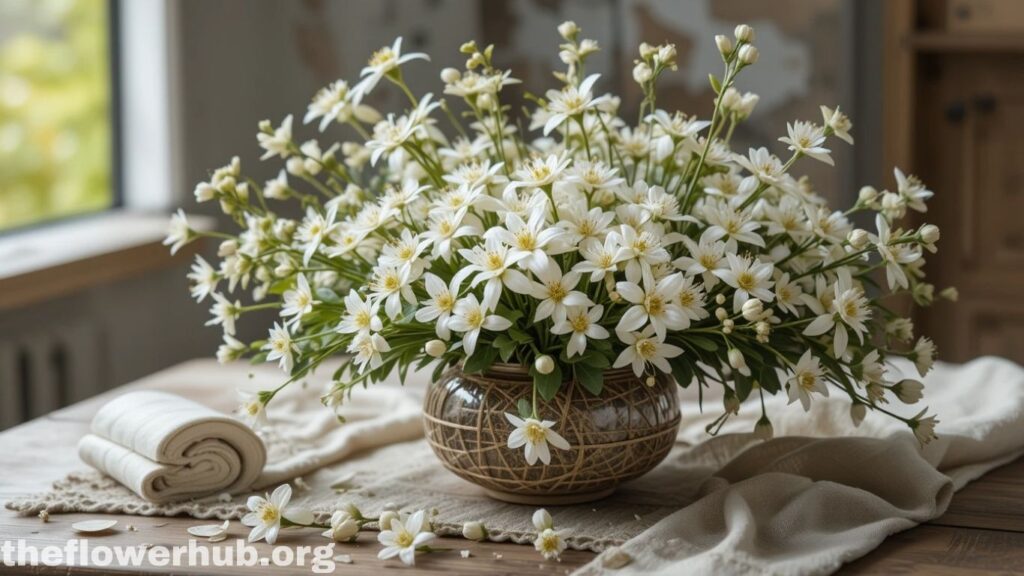Introduction
Edelweiss Flower is Not Just a Beautiful Blooming that Grows in High Mountain Areas The flower of edelweiss (Leontopodium alpinum)/fwlink.#BACKGROUND is far more than a pretty flower that grows in high mountain areas. Over generations, this unique star-shaped flower has become a symbol of love, courage, purity, and fortitude. With a long history filled with war narratives and folklore, the flower is more than just a pretty blossom, its impact stretching far beyond the craggy cliffs it grows on.
In this definitive guide, we delve into the untold stories, cultural history and practical advice for this extraordinary alpine treasure. If you’re a green-thumbed gardener, a history loving horticulturist, or just drawn to this iconic bloom for inexplicable reasons, get ready to dig into every detail surrounding the Edelweiss flower.

Table of Contents
Table: Essential Quick Facts About Edelweiss Flower
| Aspect | Details |
|---|---|
| Botanical Name | Leontopodium alpinum |
| Edelweiss Other Names | Alpine Star, Wool Flower |
| Family | Asteraceae |
| Origin | European Alps, Carpathians, Pyrenees |
| Flower Form | Star-shaped, woolly white bracts, yellow Center |
| Iconography Symbolism | Purity, strength, loyalty, devotion, love of all kinds |
| Bloom Period | June to September |
| Growing Zones (USDA) | 4 to 7 |
| Preferred Soil | Well-drained, gritty, alkaline |
| Sun Exposure | Full sun |
The Edelweiss Flower: A Historical Trek
The edelweiss flower is iconic in European history and legend. Its scientific name comes from German edel (meaning noble) and weiss (meaning white) which describes the purity and nobility of this flower.
Edelweiss Flower in Folklore
Centuries ago dashing young men would climb deadly alpine cliffs to pick Edelweiss flowers for their girlfriends, risking life and limb. The flower was therefore a symbol of courage and true love. Legend had it in some cultures that a man who is unloved could never hope to climb to, or ever find, the legendary Edelweiss.
Strategic and Military Importance
The flower had by the 19th century become a symbol of the country of Austria as well as the region of Switzerland. Impression of the edelweiss The Edelweiss would become the symbol of the Gebirgsjäger and the song was re-popularised after the Second World War.
Today, the Edelweiss flower can be found on coins, stamps, airline logos (e.g. Edelweiss Air) and even in clothing such as Lederhosen and Dirndls.
Symbolism of the Edelweiss Flower Goes Deeper Than You Think
Very well known for its rich and multi-layered symbolism through different cultures and age.
Emblem of Purity and Innocence
The pristine white of untouched landscapes (even the most more-than frozen of high mountain climes have held some shade of white), has always symbolized purity, innocence, and the unspoiled. You’ll often find it at weddings and christenings in alpine areas but you can also enjoy it in the mountains.
Bravery and Sacrifice
Its association with dangerous mountain climbs has made it more than just a pretty flower. The Edelweiss flower symbolises:
- Courage in adversity
- Persistence through hardship
- Ready for some sacrifice for love or country
Romantic Token
Historically, the Edelweiss blossom has also been associated with one of the most romantic gifts -telling the recipient how much you care about them which has made gift giving this flower an extraordinary gesture.
Growing and Caring for Edelweiss Flower
Even though the Edelweiss flower belongs to the wild mountain terrain, it can still thrive in your garden, only if you manage to replicate its natural growing environment.
Soil Requirements
- It prefers well-drained, sandy, or rocky soil.
- A pH of slightly alkaline is perfect.
- Don’t plant in dense clay or in overly wet earth.
Sunlight and Temperature
- THIS PLANT DOES BEST IN FULL SUN.
- Hardy in USDA zones 4-7.
- Cold tolerant but may struggle in areas with high humidity or extremely hot summers.
Watering and Maintenance
- Water only when dry; watering too much can cause root rot.
- After that initial period, Edelweiss is drought-proof.
- To promote good growth, cut back the dead flowers and stems.
Propagation Tips
- From seed: Start indoors, about 6-8 weeks before last frost, sow on surface; seeds require light to germinate.
- From cuttings: Uncommon but feasible under special conditions.
Companion Plants
Combine Edelweiss with other alpine or rock garden plants such as:
- Saxifraga
- Alpine poppy
- Dwarf conifers
The Cultural History And Contemporary Uses of Edelweiss Flower
The Edelweiss flower has left a mark on every aspect of cultural expression in these regions.
Music and Performing Arts
- Enshrined in the song “Edelweiss” of The Sound of Music — a number frequently assumed to be an Austrian folk song, when in fact it’s a piece by Rodgers and Hammerstein.
- Featured in local folk songs, symbolizing nostalgia and patriotism.
Literature and Poetry
Since then the Edelweiss flower has been frequently utilized in poetry to symbolize unattainable ideals, value in adversity, and purity. It is often found in the stories of true love.
Cosmetics and Herbal Medicine
Some traditional uses of the Edelweiss flower have been confirmed by modern science:
- Skin care: Plant extracts are included for their anti-oxidant and UV-protective effects.
- Herbal remedies: Traditionally used for respiratory health, digestive problems and as pain killers.
How to Conserve Edelweiss Plant and How You Can Help
Due to its widespread popularity, the Edelweiss flower became scarce in the wild by the beginning of 20th century.
Conservation Status
- In several European countries, it is illegal to pick wild Edelweiss.
- It is currently protected within its original habitat, with wild populations being closely monitored.
What Gardeners and Fans Can Do
- Buy only sustainably sourced seeds or nursery-grown plants.
- Don’t disturb those wild hordes on mountain rambles.
- Support conservation organisations protecting alpine flora.
Ecological Importance
- Feeds specialized alpine insects.
- Has been used to stabilize high elevation rocky soil.
Interesting Species and Related Varieties of Edelweiss Different Types of the Edelweiss Plant
Leontopodium alpinum is the most familiar species, but the genus comprises about 30 other species in Asia and Europe.
Notable Species
- Leontopodium nivale: Often practised as a synonym for L. alpinum in some areas.
- Leontopodium himalayanum – Native to Himalaya.
- Leontopodium japonicum: Endemic to Japan.
These relations also possess the starry shape and velvety feel that make Edelweiss visually unique.
Innovative Ways To Use Edelweiss Flower
The Edelweiss flower doesn’t only belong to gardens or mountainsides. Here is how it makes our lives more marvelous:

- Dried flower arrangements: Hold their shape and color.
- Pressed flower art: Found in cards, bookmarks, or framed pieces.
- Jewellery and art: Miniature models make popular souvenirs in alpine tourist areas.
- Souvenirs: Switzerland and Austria are filled with pins, brooches and hats bearing Edelweiss symbols.
FAQs
What is the native habitat of the Edelweiss flower?
Edelweiss is a flower that grows wild in rocky alpinine areas of the Alps, Carpathians and the Pyrenees. It is adapted to areas ranging from 1,800 to 3,000 meters above sea level.
Will Edelweiss flower in the lowlands?
Yes, if you can give it well-drained, gritty soil and full sun. But its growth is inhibited by humidness or excess heat.
Why is the Edelweiss flower referred to as the ‘Queen of the Alps’?
It’s called the Queen of the Alps, for its literally royal beauty, and because it can stand up to its tough alpine environment.
How do you dry the Edelweiss flower?
Harvest Cut flowers when fully open; hang to dry upside down in a cool, dry place with good air circulation for a couple of weeks. The flowers may be dried, and they keep their shape and white colour.
Are Edelweiss edible or medicinal?
Though not normally eaten, Edelweiss has been employed in folk medicine for its alleged pain killing and anti-inflammatory effects.
Conclusion
The Edelweiss, however, is still held dear as a symbol of the alpine world it bloomed in, symbolising purity, courage, love, and endurance. Its star-shaped flower is still a source of inspiration when witnessed clinging to a rocky ledge, flowering on a rockery or captured in art and song.
Through understanding its history, symbolism and cultivation requirements, this alpine gem can be appreciated and protected for future generations. Grow it, give it as a gift, or marvel at it yourself; the Edelweiss flower is a timeless homage to the tenacity and beauty of nature.
